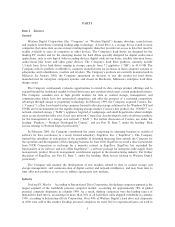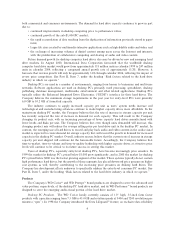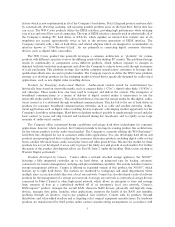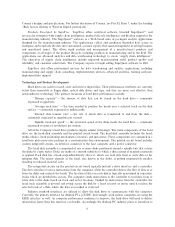Western Digital 2000 Annual Report Download - page 17
Download and view the complete annual report
Please find page 17 of the 2000 Western Digital annual report below. You can navigate through the pages in the report by either clicking on the pages listed below, or by using the keyword search tool below to find specific information within the annual report.Backlog
At September 18, 2000, the Company's backlog, consisting of orders scheduled for delivery within the
next twelve months, was approximately $294 million, compared with a backlog at August 21, 1999 of
approximately $388 million. The Company expects all this backlog to be delivered within the current Ñscal
year. Historically, a substantial portion of the Company's orders has been for shipments within 30 to 60 days of
the placement of the order. The Company generally negotiates pricing, order lead times, product support
requirements and other terms and conditions prior to receiving a computer manufacturer's Ñrst purchase order
for a product. Manufacturers' purchase orders typically may be canceled with relatively short notice to the
Company, with little or no cost to the customer, or modiÑed by customers to provide for delivery at a later
date. Also, certain of the Company's sales to computer manufacturers are made under ""just-in-time'' delivery
contracts that do not generally require Ñrm order commitments by the customer until the time of sale.
Therefore, backlog information as of the end of a particular period is not necessarily indicative of future levels
of the Company's revenue and proÑt and may not be comparable to earlier periods.
Patents, Licenses and Proprietary Information
The Company owns numerous patents and has many patent applications in process. The Company
believes that, although its patents and patent applications have signiÑcant value, the successful manufacturing
and marketing of its products depends primarily upon the technical competence and creative ability of its
personnel. Accordingly, the patents held and applied for do not assure the Company's future success.
In addition to patent protection of certain intellectual property rights, the Company considers elements of
its product designs and processes to be proprietary and conÑdential. The Company believes that its
nonpatented intellectual property, particularly some of its process technology, is an important factor in its
success. Western Digital relies upon employee, consultant, and vendor non-disclosure agreements and a
system of internal safeguards to protect its proprietary information. Despite these safeguards, there is a risk
that competitors may obtain and use such information. The laws of foreign jurisdictions in which the Company
does business also may provide less protection for conÑdential information than the United States.
The Company relies on certain technology that is licensed from other parties in order to manufacture and
sell its products. The Company has cross-licensing agreements with several competitors, customers and
suppliers, and the Company believes that it has adequate licenses and other agreements in place in addition to
its own intellectual property portfolio to compete successfully in the hard drive industry.
For additional discussion of intellectual property, see Part II, Item 7, under the heading ""Risk factors
relating to Western Digital particularly.''
Environmental Regulation
The Company is subject to a variety of regulations in connection with its operations. It believes that it has
obtained or is in the process of obtaining all necessary permits for its domestic operations.
Employees
As of June 30, 2000, the Company employed a total of 7,321 full-time employees worldwide. This
represents a reduction in headcount of approximately 30% since July 3, 1999, as the Company responded to
the industry downturn and its decrease in sales by restructuring and exiting the enterprise hard drive market.
The Company employed 1,090 employees in the United States, 6,040 employees in Malaysia, 85 in Singapore,
and 106 at its international sales oÇces as of such date.
Many of the Company's employees are highly skilled, and the Company's continued success depends in
part upon its ability to attract and retain such employees. Accordingly, the Company oÅers employee beneÑt
programs which it believes are at least equivalent to those oÅered by its competitors. Despite these programs,
the Company has, along with most of its competitors, experienced diÇculty at times in hiring and retaining
certain skilled personnel. In critical areas, the Company has utilized consultants and contract personnel to Ñll
these needs until full-time employees could be recruited. The Company has never experienced a work
12
























